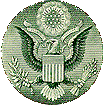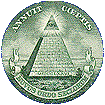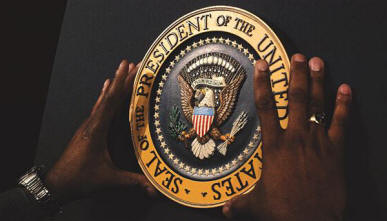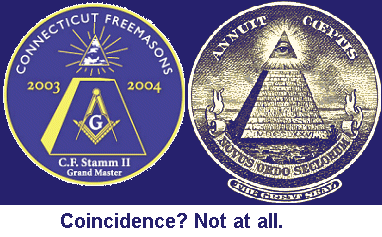
It's all about the Masons
For conspiracy theorists in particular (and also for those who like to see doggies and horsies in puffy cloud formations), it's a wonderful symbol on which to fixate: the Great Seal of the United States being part of some huge secret 'sign' that Freemasonry rules everything - and proven by the seal being on the United States' one dollar bill. (Wouldn't you think they would have made a THREE dollar bill and put it on there? After all, ONE isn't one of those magical, mystical Masonic numbers you read about, is it?)
Curiously, this theory is sometimes reinforced by naive Masons repeating an oft-heard (but totally erroneous) claim that Masons did, in fact, design the seal.

 Reality, however, is quite different.
Reality, however, is quite different.
Only one person involved in the initial (not the ultimately approved) design
was thought to be a Mason; the man who did the design (Hopkinson) -
yet there is no proof
whatsoever of his Masonic membership!
The designing of a seal of the U.S. was first commissioned by the Continental Congress immediately after the signing of the Declaration of Independence on July 4, 1776. A committee consisting of Benjamin Franklin (a Mason), John Adams (not a Mason), and Thomas Jefferson (not a Mason although sometimes erroneously identified as one) submitted a design that was deemed unacceptable, as were designs submitted by two succeeding committees. In 1782 (nearly six years later!) these designs were submitted to Charles Thomson, Secretary to the Continental Congress, (and NOT a Mason) who prepared a design which, with some alterations, was adopted by the Congress on June 20, 1782.
The United States Department of State has an excellent publication titled The Great Seal of the United States which you can download in Adobe PDF Format. It's available here and there's more information here.
![]()
Don't forget the eye!
 There are also some specific items in the Great Seal that attract attention,
specifically the eye in the pyramid. For more detailed information on that,
please see our separate page here.
There are also some specific items in the Great Seal that attract attention,
specifically the eye in the pyramid. For more detailed information on that,
please see our separate page here.
![]()
Details for your consideration
Here's some additional, detailed information about the Seal, all of which is thanks to the research of Texas Mason Bill Maddox to whom this site's author is grateful for his resourcefullness.
In a book titled THE EAGLE AND THE SHIELD - A History of the Great Seal of the
United States (1976), on Page 529: "Did Freemasonry Influence the Great
Seal Design?"
"Because membership records for the Revolutionary period are scattered and imperfect, it is not possible to ascertain with certainty which
persons among the 14 who participated in the designing of the Great Seal were Masons and which were not. Conrad Hahn, Executive Secretary of the
Masonic Service Association of the US has furnished the following:
1. Definitely a Mason: Bro. Ben Franklin.
2. Definitely not: John Adams and Charles Thomson.
3. No firm evidence of a Masonic connection, although allegations of
such a connection have been noted: Jefferson, Lovell, Hopkinson,
Middleton, Rutledge. (Masonicinfo note: Based on more
current research, it is now accepted that Jefferson was not a Mason!)
4. No record at all, so presumably not Masons: Du Simitiere, Scott,
Houston, Lee, Boudinot, and William Barton (although
he has at times been confused with another William Barton who was a Mason).
Although
Washington was a Mason, he played no role in designing the Great Seal. And although
Benjamin Franklin, a Mason and Past Grand Master of Pennsylvania, was a member of the first
seal committee, his proposal (P14) had no influence on the final designs, and he was in France when those designs were drawn up. The
only individual listed who has been said to be a Mason (with no firm
evidence) is
Hopkinson, whose pyramid design for the Continental currency's $50 bill clearly influenced the final reverse of the Great
Seal.
The pyramid, the eye, and the radiant triangle have often been considered to be of Masonic origin. Writers who are Masons have
also seen Masonic symbolism in the eagle, in the number of feathers on the eagle's wings, etc. It should perhaps be noted that some of the details
studied and interpreted by these writers are those of comparatively recent realizations of the Great Seal, details which are not stated in
the blazon itself and are not to be found in the Great Seal die of 1782.
Without questioning the fact that element of the Great Seal design are also to be found as Masonic symbols, one may question whether the
designers of the seal intended it to be given a specifically Masonic interpretation. Since there is no evidence that either Thomson or
Barton was a Mason, and as they were the two individuals responsible for the final design, the presumption would be that they did not intend
their work to be given a Masonic interpretation.
Were there sources other than Freemasonry from which symbols such as the all-seeing eye and the unfinished pyramid could have been taken? The
answer is yes. Use of the eye in art forms, including medallic art, as a symbol for an omniscient and ubiquitous Deity was a well established
artistic convention quite apart from Masonic symbolism, and DuSimitiere, an artist, would have been aware of this. As to the Pyramid,
there was widespread interest in Egypt in the 18th century. There was a detailed work entitled
Pyramidographia which would have been available to both Hopkinson and Barton. This work included a drawing of the
"First Pyramid", which was stepped, did not come to a complete point, and had an entrance in the center on the ground level-a detail also in
Hopkinson's design.
While these points are not conclusive, it seems likely that the designers of the Great Seal and the Masons took their symbols from
parallel sources, and unlikely that the seal designers consciously
copied Masonic symbols with the intention of incorporating Masonic
Symbolism into the national Coat of Arms."
<emphasis added>
![]()
Further from the same book:
Use of the motto "In God We Trust" - P518
From the House Committee on the Judiciary (3/28/1956)
This joint resolution establishes "In God We Trust" as the national
motto of the U.S. At present the U.S. has no national motto. It is
most appropriate that "In God We Trust" be so designated.... Further
recognition of this motto was given by the adoption of the Star-Spangled Banner as our national anthem. One stanza ... is as follows:
"And this be our motto -- 'In God is our trust.'"
On page 75 are Charles Thomson's notes on his design - A pyramid unfinished - In the Zenith an Eye in a triangle ...
Over the Eye these words Annuit coeptis ... and underneath [the pyramid] these words Novus Ordo seclorum." The pyramid was taken
from an earlier design of William Barton (shown on page 67) that had a different motto
DEO FAVENTE (God favoring) PERENNIS (through the years). This, in turn, was similar to the design of a Fifty
Dollar bill designed by Francis Hopkinson. Thomson wrote the following: "The pyramid signifies Strength
and Duration: The Eye over it & Motto allude to the many signal interpositions of
providence in favour of the American cause. The date underneath is that of the Declaration of
Independce and the words under it signify the beginnings of the New American Era, which commences from
that date." P85.
P89. "The two mottoes which Thomson suggested, and Congress adapted, for the reverse ... can be traced more definitely to the poetry of Virgil.
Gaillard Hunt, in the Department of States first publisher on the seal in 1892, took official notice .... Annuit Coeptis, was described by Hunt
as an allusion to line 625 of book IX of the Aeneid JUPPITER OMNIPOTES, AUDACIBUS ANNUE COEPTIS (All-powerful Jupiter favor [my] daring
undertakings). The last three words appear also in Virgil's GEORGICS, book I, line 40: DA FACILEM CURSUM, ATQUE AUDACIBUS ANNUE COEPTIS (Give
[me] an easy course, and favor [my] daring undertakings). Thompson changed the imperative ANNUE to ANNUIT, the third person
singular form of the same verb in either the present tense of the perfect tense. The the motto ANNUIT COEPTIS the subject of the verb
must be supplied, and the translator must also choose the tense. In his 1892 brochure, Hunt suggested that the missing subject was in effect the
eye at the apex of the pyramid ... and he translated the motto-in the present tense-as "it (the Eye of Providence) is favorable to our
undertakings." In later publication the missing subject of the verb ANNUIT was construed to be God, and the motto has been translated in more recent Department
publications - in the perfect tense - as "He (God) has favored our undertakings".
P90. NOVUS ORDO SECLORUM, Hunt noted an allusion to line 5 of Virgil's ECLOGUE IV, which read in an eighteenth-century edition : "MAGNUS AB
INTEGRO SECLORUM NASITUR ORDO". Hunt translated this line as "The great series of ages begins anew" and translated the motto as "a new order of
centuries." More recently, "a new order of the ages."
P91. Hunt stated that the words ANNUIT COEPTIS NOVUS ORDO SECLORUM had "commonly been taken as one motto, meaning
'the new series of ages is
favorable to our undertakings'", but he pointed out that it was evident from Thomson's comments that the
"intention was to have two mottoes."
![]()
Those seals are everywhere
Because of the use of "seals" in official documents, the Great Seal of the United States appears in many places. Needless to say, conspiracy theorists consider this as part of a huge cabal to send secret signals - to who? Well, to YOU the 'shepple' apparently but so what? In the 225 years since the Great Seal came into being, the Masons haven't managed to take over the world yet and, in fact, their numbers have diminished considerably in recent years. Sheesh: when there were five million or so Masons, wouldn't that have been just a SUPER time to grab control?
 In their
zeal, those completely absorbed by this conspiracy concept totally disregard history and how seals have been used throughout the ages. This
object of their fascination now appears on a wide variety of documents, including presidential
proclamations, instruments of ratification of treaties, and the
commissions of cabinet officers, ambassadors, and other foreign service
officers so it's great fodder for their fantasies.
In their
zeal, those completely absorbed by this conspiracy concept totally disregard history and how seals have been used throughout the ages. This
object of their fascination now appears on a wide variety of documents, including presidential
proclamations, instruments of ratification of treaties, and the
commissions of cabinet officers, ambassadors, and other foreign service
officers so it's great fodder for their fantasies.
Incidentally, the U.S. presidential seal is similar to the Great Seal, but differs from it in the border inscription "The Seal of the President of
the United States." And yes, that IS a Masonic ring
on the hands of the person placing the seal.
![]()
Masons use the symbol themselves!
On Christmas eve, 2006 an anonymous message (apparently the sender was afraid that the black helicopters would come down his/her chimney or something) sent a link to this photo:
The caption below it was added by the originator and not by masonicinfo.com. Needless to say, it's obviously NOT coincidence. It appears that we now, at long last, have proof that the Great Seal was designed in the 1770-1780 period by Connecticut Masons from 2003-2004. Doubt it not!
And we probably shouldn't even mention that the Grand Master, "Chip" Stamm whose name you can see on that coin on the left, is the person who now heads the program which Masonic detractors like to claim is somehow involved with implants for ultimate identification and takeover of the world, which claims make the Masons involved laugh uproariously: Masonic ChIP. Read more about it here.
Last updated 30 December 2010
|
Related Topics: |
|
In addition, |
